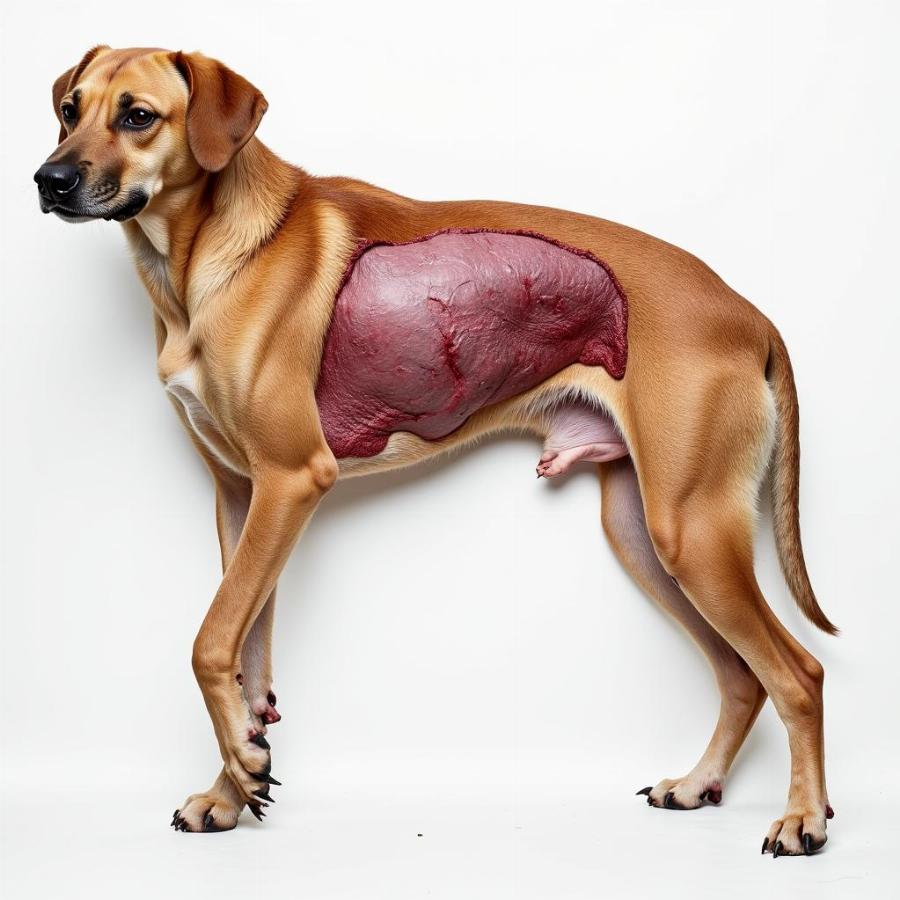Rigor mortis in dogs, the stiffening of muscles after death, is a natural process that can be distressing for owners. Understanding what rigor mortis is, why it happens, and its timeline can help prepare owners for this difficult experience and distinguish it from other conditions. This article will provide a comprehensive guide to rigor mortis in dogs, offering insights into the science behind the phenomenon and guidance for pet owners facing this challenging time.
Understanding Rigor Mortis in Dogs
Rigor mortis, translated from Latin as “stiffness of death,” is a post-mortem change that occurs in all mammals, including dogs. It’s characterized by the stiffening of the body’s muscles due to chemical changes within muscle cells. While emotionally difficult to witness, it’s a normal part of the death process.
 Chó trong giai đoạn đầu của co cứng tử thi
Chó trong giai đoạn đầu của co cứng tử thi
The process begins a few hours after death, starting with the smaller muscles of the face and jaw, gradually progressing to the larger muscles of the limbs and torso. This progression is why sometimes it appears that a recently deceased dog is “smiling” or has its eyes open slightly.
The Science Behind Rigor Mortis
The onset of rigor mortis is due to the cessation of ATP (adenosine triphosphate) production. ATP is the energy source that allows muscle fibers to contract and relax. Without ATP, calcium ions flood the muscle cells, causing the muscle fibers to bind together, resulting in stiffness.
As the body further decomposes, the muscle fibers eventually break down, causing the stiffness to dissipate. This process, known as resolution, is influenced by environmental temperature, the dog’s size, and the cause of death.
Timeline of Rigor Mortis in Dogs
While the timeline can vary, rigor mortis typically follows this pattern:
- 2-6 hours after death: Rigor mortis begins, often noticeable in the face and jaw.
- 12-24 hours after death: Rigor mortis is complete, affecting the entire body.
- 24-48 hours after death: Rigor mortis begins to subside, starting with the smaller muscles.
- 48-72 hours after death: Rigor mortis is completely resolved.
It’s important to remember these are estimates and variations can occur. Environmental temperature plays a significant role. Higher temperatures accelerate the process, while lower temperatures slow it down.
What Rigor Mortis Can Tell Us
While primarily a natural part of death, the onset and duration of rigor mortis can sometimes provide clues about the time of death, although it’s not a precise method. Veterinarians might consider this information, along with other factors, when determining the cause of death.
What to Do When You Notice Rigor Mortis in Your Dog
Discovering your dog in rigor mortis is undoubtedly a painful experience. It’s crucial to remember that this is a natural process. What happens to a dog when it dies provides a comprehensive guide to help you navigate this difficult time. You should contact your veterinarian or a local pet cremation service. They can provide guidance and assistance with after-death care options. What to do when your dog dies at home and what do you do if your dog dies at home offer additional helpful resources.
Conclusion
Rigor mortis in dogs is a natural and unavoidable part of the death process. While witnessing it can be emotionally challenging, understanding the science behind it can provide some comfort. Remember that your veterinarian and other pet after-care services are available to provide support and guidance during this difficult time. Don’t hesitate to reach out for help and resources.
FAQ
-
Is rigor mortis painful for the dog? No, rigor mortis occurs after death, when the dog is no longer conscious or feeling pain.
-
Can I move my dog after rigor mortis sets in? Yes, but the body will be stiff. Handle your dog with care and respect.
-
Does rigor mortis happen to all dogs? Yes, it’s a natural process that occurs in all mammals after death.
-
How long does rigor mortis last in dogs? Typically, it lasts between 24 and 72 hours, depending on environmental factors and the dog’s size.
-
Should I be concerned if rigor mortis sets in quickly or slowly? While variations can occur, significant deviations from the typical timeline might warrant further investigation by a veterinarian.
-
What should I do if I find my dog in rigor mortis? Contact your veterinarian or a local pet cremation service for guidance and assistance.
-
Is rigor mortis a sign of a specific disease? No, it’s a natural part of the death process, not a disease indicator.
Beaut Dogs is your trusted source for comprehensive and compassionate information on all aspects of dog ownership, including end-of-life care. We are committed to providing expert advice and support to help you navigate every stage of your dog’s life. When you need support, please contact Email: [email protected] to have Beaut Dogs answer in detail and accurately. Visit us at https://beautdogs.com for more helpful resources and information.